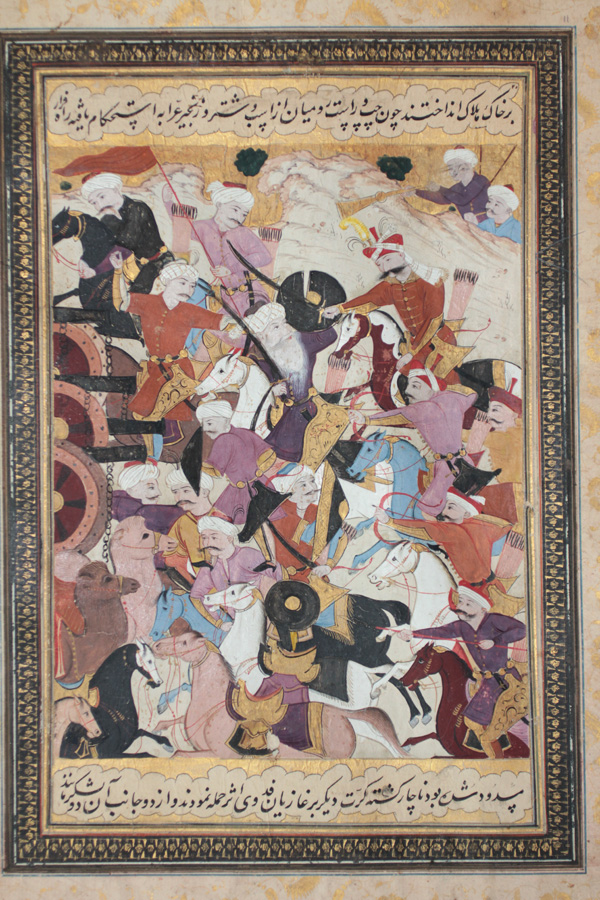Location: Private Collection
Mount: beige mount with gold decoration; blue collar. Mount size: 31.5 x 22 cm (after Christies); 35.6 x 23.5 cm (after Anderson)
Written surface: 23.8 x 15.3 cm. (scaled)
Painting: 19.5 x 15.3 cm. (scaled)
Text references: J.K., p.532 line 10 and lines 11-14.
(a few words have been omitted at the end of line 10 and beginning of line 11)
See Savory, SA_1979, p.72 for this event in the History of Shah ʿĀbbās.
Date of this event: 922/1516-17.
The Safavids were decisively defeated by the Ottomans at the battle of Čālderān in 920/1514 (see folio 502), and many of the qezelbāš emirs, including Khan Moḥammad ʿOstājlu the governor of Diār Bakr, were killed. Sultan Selim triumphantly entered Tabriz, but occupied the city for only a short time. When news of the Ottoman withdrawal reached the shah, he returned to his capital Tabriz, and commenced repairing the damage wrought by the Ottomans.
Qarā Khan, the brother of Khān Moḥammad, was appointed governor of Diār Bakr, and took up residence in Mārdin. But the city of Āhmed, under the control of Aḥmad Čelebi, remained loyal to the Ottomans. Two years later, in 922/1516-17, Qarā Khan took punitive action against Aḥmad Čelebi, but before he could carry out his plan, Aḥmad Čelebi summoned the Ottomans for assistance, which arrived in the form of 20,000 troops commanded by Moṣṭafā Pāšā Biǧlu Čāleš. Subsequently, Qarā Khan ordered the town surrounded and its life lines interrupted. After the plan had some effect, the Turkish commander sent a contingent of 5000 troops out of the fortress in an effort to break the Safavid stranglehold, but this force was readily defeated by Ǧodurmiš Solṭān (also known as Durmiš Ḵān Qājār). Several days later word reached Qarā Khan that the main force of 20,000 Turks had emerged from the fortress and were prepared to fight. Simultaneously, a message was received from Esmāʿil advising Qarā Khan not to engage the Ottomans until Safavid reinforcements had arrived. Durmiš Khan convinced Qarā Khan that their arrival would be too late to be effective, and the following day attack orders were issued. The Safavid onslaught was successful, and the Ottoman escape route was apparently obstructed by their supply train which had been chained together, permitting the ǧāzis to inflict heavy losses. However, Qarā Khan was struck by a stray bullet and died. Stupefied by this sudden reversal, the qezelbāš scattered in all directions, and the Ottomans were able to convert total defeat into victory. Reinforcements arrived from Turkey and the Ottomans annexed the province of Diār Bakr. Upon hearing of the untimely death of Qarā Khan, Esmāʿil cancelled the order to send reinforcements, apparently having already lost his taste for battle at Čālderān.
The painting depicts the battle at the height of the Safavid near-victory. The qezelbāš occupy the right half of the composition, and are pursuing their adversaries with a vengeance. Altogether five mounted ǧāzis and nine Ottomans are depicted. Two participants are identified by inscription: Qarā Khan in the upper right, and Mostafā Pasha, the bearded figure near the center. The same subject was represented in the earlier version of Bijan's manuscript (cf. ms.L f.266v). Two corrections are evident in the later version, probably the result of Bijan's insistence on correctness. Firstly, the Ottoman commander Moṣṭafā Pāšā, is no longer portrayed wearing the the tall Ottoman headgear symbolic of the Sultan; he is now wearing a turban more compatible with his rank. Secondly, there is no evidence that he died in this battle as shown in the earlier version; this too has been coreected in the later version.
Painting references:
Anderson Gallery, February 29 - March 1, 1924, Lot 300
Christie's Paris,, 7 July 2010, Lot 132
Provenence: Collection of Reżā Khan Monif in New York until his death in 1923. Sold at estate auction at Anderson Galleries in 1924; purchaser not known. Re-appears in 2010 in the Collection of Darthea Speyer at Christies auction; it is not known when and where Ms. Speyer purchased the painting. Purchased 2010 at Christies by the present owner.
Photo courtesy of present owner.
Robert Eng
Last Updated: January 17, 2013| Originally published:January 17, 2013
